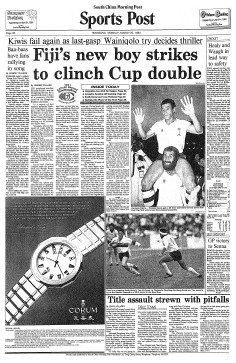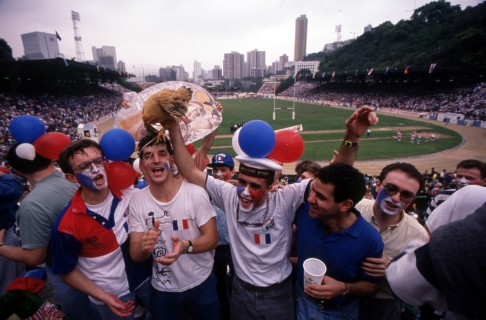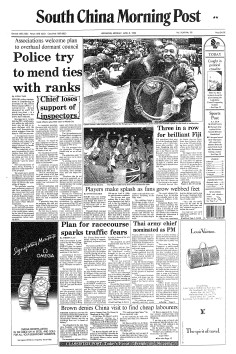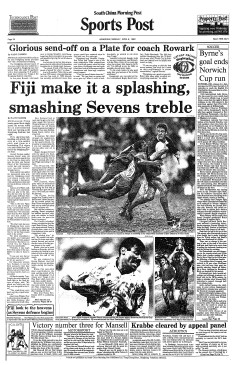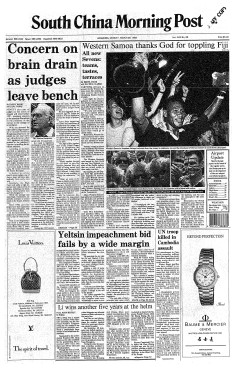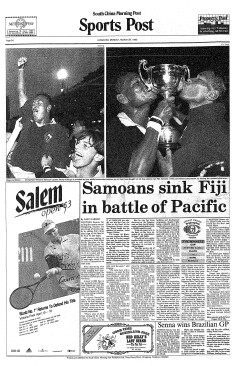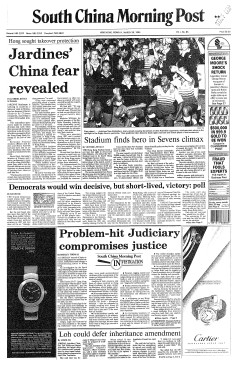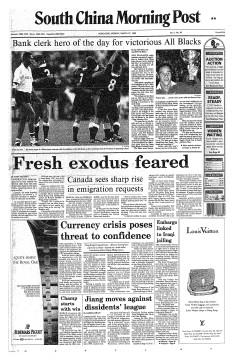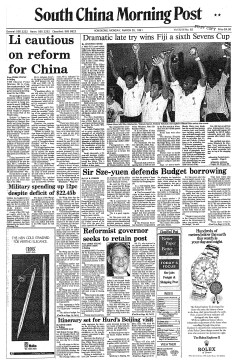
Lomu and the Pieman star in Hong Kong Sevens history
IN PICTURES: 40 years of the Hong Kong Sevens - part 4 (1991-1995). Join us for an eight-part romp through the SCMP archives looking at how the world-famous event grew from humble beginnings to become a phenomenon

From humble beginnings in 1976, the Hong Kong Sevens has grown into the city's leading sports event, famed throughout the world. This year, as the tournament celebrates 40 years, we're taking a ride through the SCMP archives to see how the event became the jewel in the sevens crown.
And if you see yourself or a friend in any of the pictures in our eight-part series, click here to enter your best memories of the Sevens and the most original/entertaining answers will win a pair of three-day tickets to this year’s Cathay Pacific/HSBC Hong Kong Sevens from March 27-29.
Part 4 of our coverage begins in 1991, with France and Scotland making their debuts and the first appearance of a perennial Sevens story - police warning that hundreds of tickets could be in the hands of touts. "There was uproar last month when the 12,300 tickets reserved for Hong Kong sold out within two hours," the SCMP said on its front page. Despite that, a news report from day one of the tournament says doormen gave away tickets that fans failed to sell outside the stadium.
Fiji delighted the crowd again after a repeat of the 1990 final against New Zealand, winning 18-14 this time. Timoci Wainiqolo scored the match-winning try in injury time. "That took 10 years of my life," New Zealand coach Wayne Smith told the SCMP. "It was an incredible final but sickening to lose."
Kiwi star Eric Rush was named "best and fairest player" as he and Fiji's Waisale Serevi continued to light up the event.
In the continued absence of England, the Barbarians, led by Will Carling and Jeremy Guscott, were big crowd favourites, but Fiji saw them off in the semis.
1992 was the last year at the old Government Stadium before it was flattened to become the current Hong Kong Stadium - partly as a consequence of the ever-increasing demand for Sevens tickets. To ensure the tournament wouldn't be jeopardised, a plan was put in place to have a functional half-completed stadium for 1993, before the "space-age" venue was ready for the 1994 tournament. Twenty-three years later, the venue is looking less space age than stone age.
Fiji said they were praying for rain in the build-up and they got their wish as a monsoon descended.
"There's little chance of a lightning strike in the middle of the pitch," Hong Kong Rugby Football Union chairman Don Watson told the SCMP, as he decided the show must go on.
On the Sunday, 78 millimetres of rain fell, drenching the crowd in the uncovered stands and turning the pitch into a swamp.
Fiji revelled in the mud in the final as they made it three wins in a row, beating the All Blacks again 22-6. Forward Mesake Rasari, flown in from Lebanon where he was part of the UN peacekeeping force, scored a hat-trick in the final and was named player of the tournament, narrowly edging out Serevi.
Hong Kong won the Plate, Gareth James scoring an extra-time try against Western Samoa to give coach Jim Rowark another piece of silverware in his last game in charge.
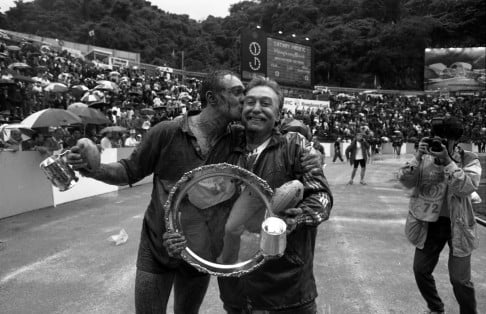
1993 saw Sevens regulars discombobulated as they tried to get accustomed to the new half-built stadium. Around 33,000 attended each day.
This was also the first of many "last tournaments ever" for Aussie great David Campese. He limped off injured in a semi-final defeat by a Serevi-inspired Fiji. Having trouble sticking to his decision, he would make several more appearances.
The new stadium meant the birth of a new Sevens tradition, with the biggest partiers gravitating for whatever reason to the South Stand - despite moans from some regulars that the new stadium would kill off the party atmosphere. Now, of course, it's legendary for its drunken debauchery.
The Springboks made their debut, inspiring one female supporter to invade the pitch topless on day one. That was about as good as it got for South Africa fans, however.
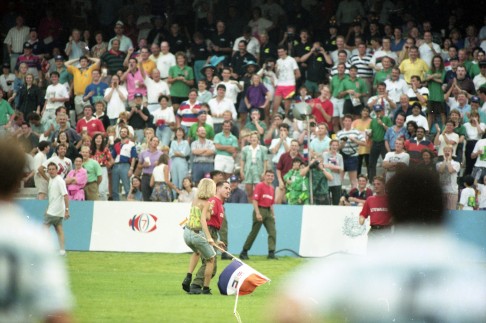
In "other news", 1993 saw Mark Roberts get naked and disrupt a sporting event for the first time, apparently inspired by the woman mentioned above. He would go on to become the "world's most prolific streaker" and was recently the subject of a short film by acclaimed documentary maker Errol Morris on ESPN.
1994 witnessed the arrival of an all-time Sevens legend: no, not Jonah Lomu, but the Pieman, a fat beer-swilling City trader from London called Martin Hollis, who became a regular fixture and in the pages of the SCMP until he lost a ton of weight and we got bored with him.
According to the SCMP, the licence granted by police to the newly finished 40,000-seat stadium would have prevented beer being sold in temporary outlets at the ground, an unthinkable prospect that required the intervention of Governor Chris Patten to solve.
On the pitch, New Zealand took the honours, with rival teams unable to cope with 18-year-old man-mountain Lomu. He outclassed greats Serevi and Campese for tries in the semis and final and was named player of the tournament, cementing his place in the All Blacks XVs team as their then youngest ever cap. He and Glen Osborne led the team to a 32-30 win over Australia. And Hong Kong won some more silverware, their third Bowl, with a win against Portugal.
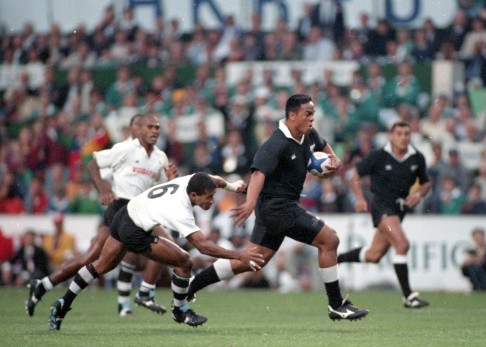
England's debut ended in the quarter-finals with defeat against Australia, while Hong Kong won the Bowl for a fourth time. This was also the first year the SCMP noted that the South Stand revelry seemed to be "becoming a tradition".
Roll of Honour:
1976 Cantabrians (New Zealand) 24 - Wallaroos (Australia) 8
1977 Fiji 28 - Marlborough (New Zealand) 18
1978 Fiji 14 - Manawatu (New Zealand) 10
1979 Australia 39 - Western Samoa 3
1980 Fiji 12 - Scottish Co-optimists 8
1981 Barbarians 12 - Australia 10
1982 Australia 18 - Scottish Border 14
1983 Australia 14 - Fiji 4
1984 Fiji 26 - New Zealand 0
1985 Australia 24 - Public School Wanderers 10
1986 New Zealand 32 French Barbarians 12
1987 New Zealand 12 Fiji 6
1988 Australia 13 New Zealand 12
1989 New Zealand 22 Australia 10
1990 Fiji 22 New Zealand 10
1991 Fiji 18 New Zealand 14
1992 Fiji 22 New Zealand 6
1993 Western Samoa 14 Fiji 12
1994 New Zealand 32 Australia 30
1995 New Zealand 35 Fiji 17
Don't forget to enter here if you see yourself or a friend in the first four of our eight-part photo series.
Part 5 is on Wednesday.
